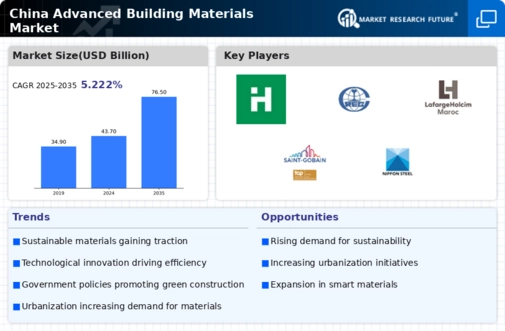Urbanization and Infrastructure Development
Rapid urbanization in China is a critical driver for the advanced building-materials market. As cities expand and populations increase, there is a heightened demand for innovative building solutions that can accommodate growing urban populations. The Chinese government has committed substantial investments in infrastructure development, with an estimated $1 trillion allocated for urban projects over the next decade. This influx of capital is likely to stimulate the demand for advanced materials that offer durability, energy efficiency, and cost-effectiveness. Consequently, the advanced building-materials market is expected to witness a compound annual growth rate (CAGR) of around 12% through 2025, as construction firms seek to leverage these materials to meet the needs of modern urban environments.
Regulatory Support for Sustainable Practices
The advanced building-materials market in China is experiencing a notable boost due to increasing regulatory support for sustainable construction practices. The government has implemented various policies aimed at promoting eco-friendly materials and reducing carbon emissions in the construction sector. For instance, the introduction of stricter building codes and standards encourages the use of advanced materials that meet sustainability criteria. This regulatory environment is expected to drive market growth, as companies adapt to comply with these regulations. In 2025, the market is projected to grow by approximately 15% as more builders opt for materials that align with government mandates. This trend indicates a shift towards a more sustainable construction industry, which is likely to benefit the advanced building-materials market significantly.
Rising Demand for Energy-Efficient Solutions
The growing emphasis on energy efficiency in construction is a significant driver for the advanced building-materials market in China. With rising energy costs and environmental concerns, builders are increasingly seeking materials that contribute to energy savings and lower operational costs. Advanced materials, such as insulated concrete forms and energy-efficient glass, are gaining traction as they help reduce energy consumption in buildings. In 2025, the market for energy-efficient building materials is expected to reach approximately $50 billion, reflecting a robust growth trajectory. This shift towards energy-efficient solutions indicates a broader trend within the construction industry, where the advanced building-materials market is poised to play a crucial role in achieving sustainability goals.
Technological Advancements in Material Science
Technological advancements in material science are significantly influencing the advanced building-materials market in China. Innovations such as nanotechnology and smart materials are enhancing the performance and functionality of building materials. These advancements allow for the development of materials that are not only stronger and lighter but also possess self-healing properties and improved thermal insulation. As a result, construction companies are increasingly adopting these advanced materials to enhance building efficiency and longevity. The market is projected to grow by 10% annually as these technologies become more accessible and affordable. This trend suggests that the advanced building-materials market will continue to evolve, driven by ongoing research and development in material science.
Increased Investment in Green Building Initiatives
Investment in green building initiatives is emerging as a pivotal driver for the advanced building-materials market in China. As awareness of environmental issues grows, both public and private sectors are channeling funds into projects that prioritize sustainability. The government has launched various incentives to encourage the adoption of green building practices, including tax breaks and subsidies for using advanced materials. This financial support is likely to stimulate market growth, with projections indicating a 20% increase in the adoption of green materials by 2025. Consequently, the advanced building-materials market is expected to benefit from this influx of investment, as more construction projects aim to meet green certification standards.
















Leave a Comment